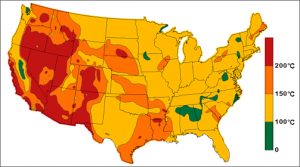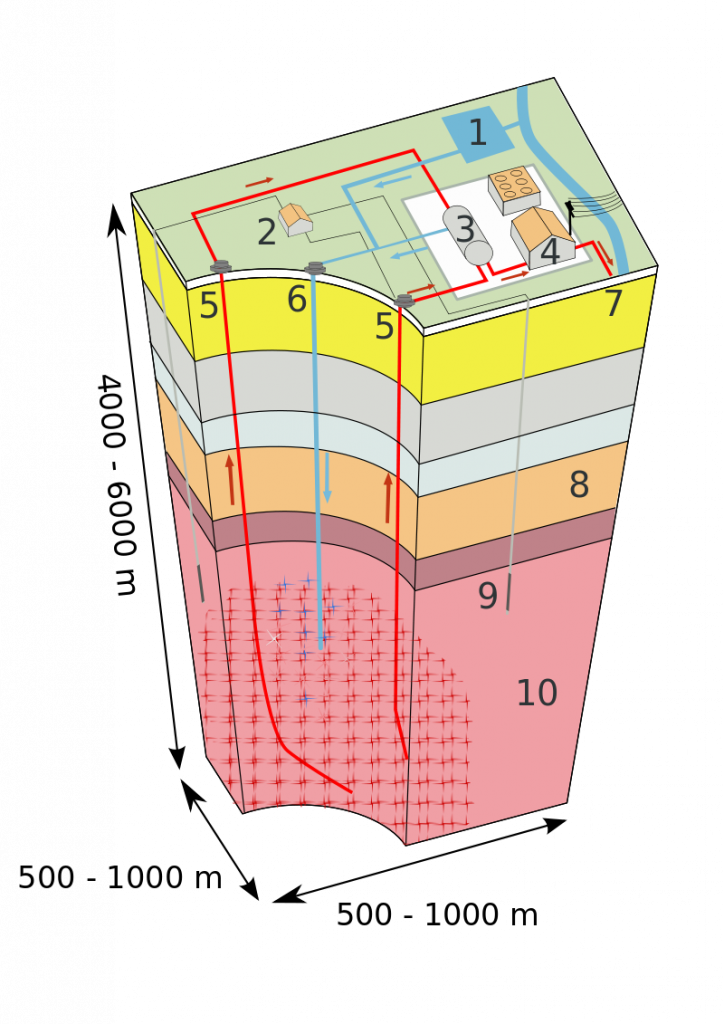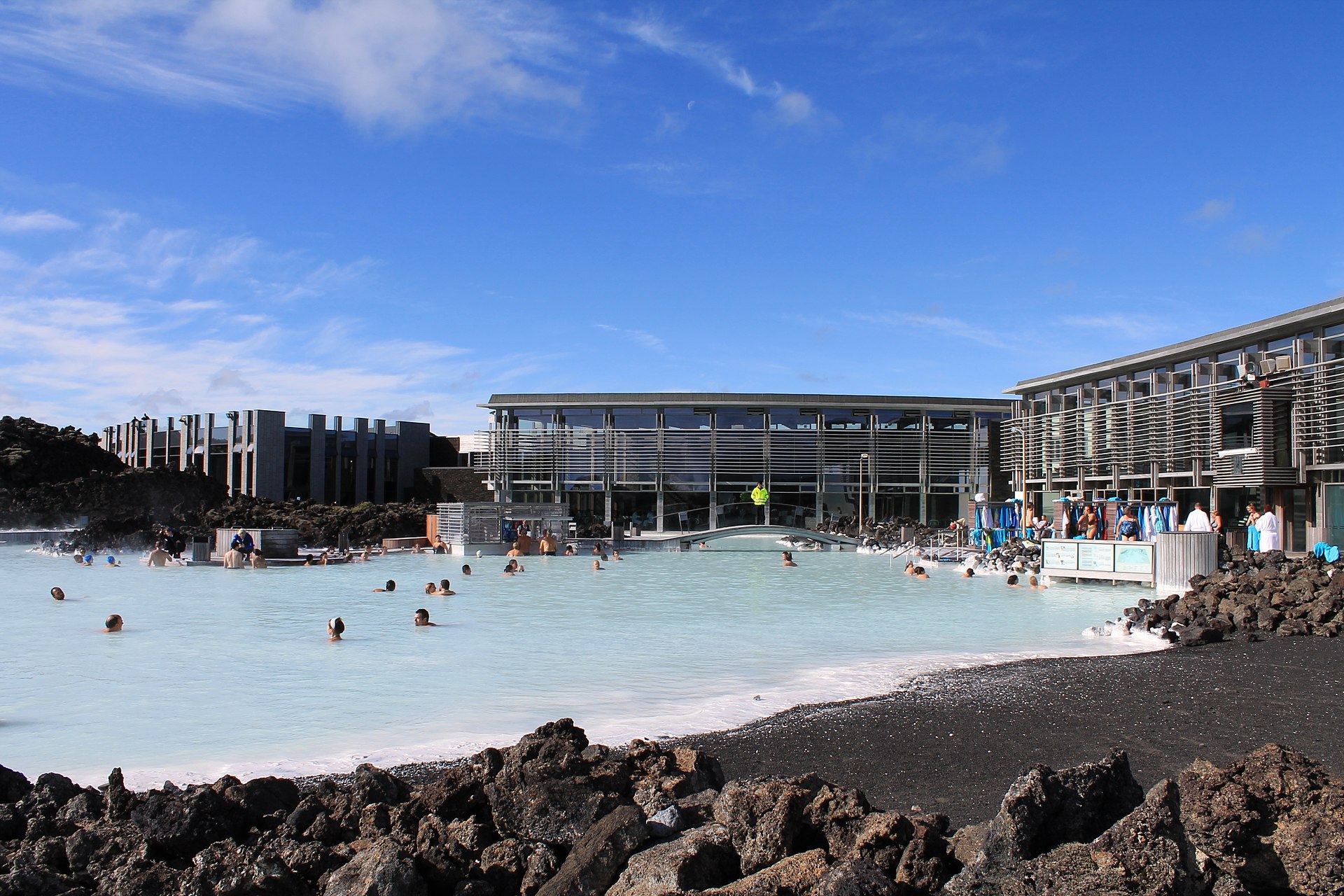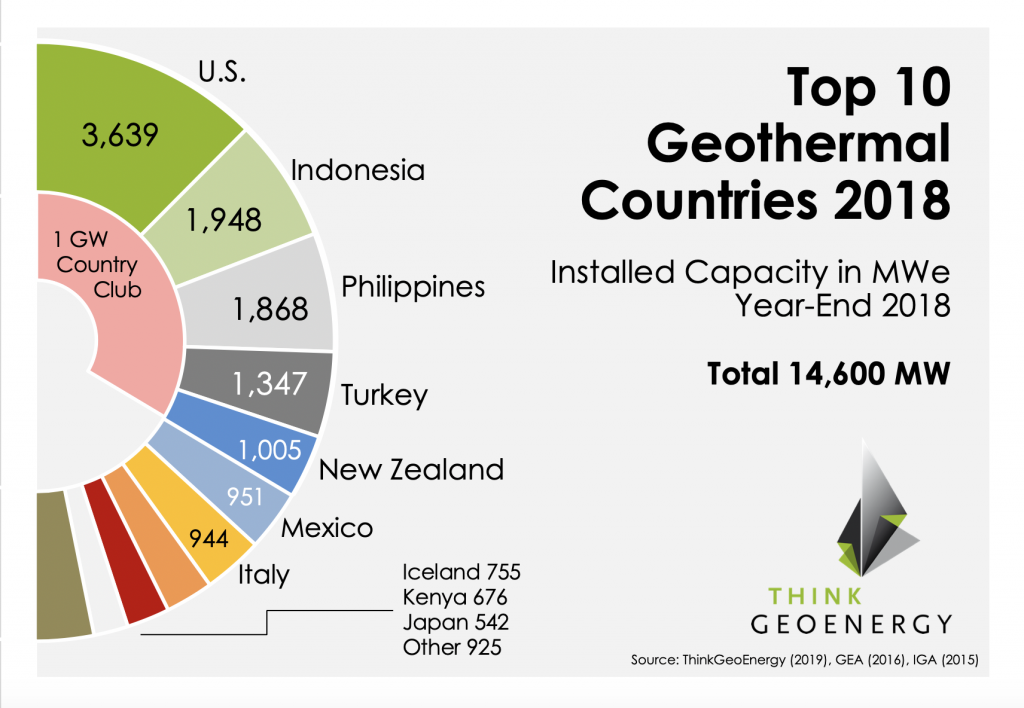10.12 Geothermal Energy
Jeff Simpson and Carolina Londono Michel
Learning Objectives – By the end of this chapter, you should be able to do the following.
- Explain how a geothermal plant produces electricity.
- Identify the parts of the US with the greatest geothermal resources.
- List advantages and disadvantages of geothermal energy.
Geothermal Energy
Video 10.12.1 – Geothermal 101 (2:08)
Geothermal energy comes from heat deep below the surface of the Earth. Nothing must be done to the geothermal energy. It is a resource that can be used without processing.
Geothermal energy uses heat from the Earth’s internal geologic processes in order to produce electricity or provide heating. If extracted carefully, the subsurface temperature of the Earth can provide a plentiful (but not endless) energy resource.
One type of geothermal energy is steam. Groundwater percolates down through cracks in the subsurface rocks until it reaches rocks heated by underlying magma, and the heat converts the water to steam. Sometimes this steam makes its way back to the surface in the form of a geyser or hot spring. Wells can be dug to bring that steam up to Earth’s surface where it can drive turbines to produce electricity.
The heat that is used for geothermal power may come to the surface naturally as hot springs or geysers. Where the pressure is not enough to bring water to the surface, engineers may pump cool water into the ground. The water is heated by the hot rock and then pumped back to the surface for use. The hot water or steam from a geothermal well spins a turbine to make electricity.

Hot water can be circulated to heat buildings. Iceland uses this kind of geothermal heat to warm houses, offices, greenhouses, nd even a series of outdoor swimming pools.
The above video does make one error. Geothermal energy is being developed outside of tectonically active areas. Enhanced geothermal systems (EGS) generate energy from hot, dry, impermeable rock that can be found at depth around the world. EGS technologies enhance and/or create geothermal resources in this hot dry rock (HDR) through ‘hydraulic stimulation’ or fracking. Water then is injected into the hot rock. That hot water creates the heat that drives the turbines and generators.


Regions near tectonic plate boundaries have the best potential for geothermal activity as geothermal systems require heat, permeability, and water. The heat from the Earth’s core continuously flows outward. Sometimes the heat, as magma, reaches the surface as lava, but it usually remains below Earth’s crust, heating nearby rock and water — sometimes to levels as hot as 700°F. Hot water or steam can be trapped in permeable and porous rocks under a layer of impermeable rock and a geothermal reservoir can form.
To develop electricity from geothermal resources, wells are drilled into a geothermal reservoir. The wells bring the geothermal water to the surface, where its heat energy is converted into electricity at a geothermal power plant. Geothermal power plants do not burn fuel to generate electricity so their emissions are very low [6].

Video 10.12.2 – Why Don’t We Run on Geothermal Energy (14:37)
Advantages of Geothermal Energy
The environmental impact of geothermal energy depends on how it is being used. Direct use and heating applications have almost no negative impact on the environment. Geothermal energy is mostly clean and safe. The energy source is renewable since hot rock is found everywhere in the Earth, although in many parts of the world the hot rock is not close enough to the surface for building geothermal power plants.
While geothermal energy does release some sulfur, geothermal plants emit 97% fewer sulfur compounds that cause acid rain than fossil fuel plants.
Disadvantages of Geothermal Energy
Geothermally heated water can release dissolved gasses, including carbon dioxide, methane, ammonia, and hydrogen sulfide, although these are usually in very small quantities when compared to those released from fossil fuel plants.
Even though geothermal energy is renewable, not every plant built to capture this energy will be able to operate indefinitely because the energy relies on groundwater recharge. If the heated water is used faster than the recharge rate of groundwater, the plant will eventually run out of water. The Geysers in California started experiencing this and operators responded by injecting municipal wastewater into the ground to replenish the supply.
Patterns of geothermal activity in the Earth’s crust naturally shift over time and an area that produces hot groundwater now may not always so do. The water of many hot springs is laced with salts and minerals that corrode equipment, shorten the lifetime of plants and increase maintenance costs.
Electrical power is restricted to regions where energy can be tapped from naturally heated groundwater but most areas of the world are not rich in naturally heated groundwater. Engineers are trying to overcome this by drilling deeply into dry rock, fracture the rock, and pump in cold water which becomes heated and drawn up through an outlet well and used to generate power. However, this approach could trigger minor earthquakes [6].
Geothermal Energy and Lithium
Every once in a while in the world of energy, there is a win-win situation. As we transition away from polluting, fossil fuel-based internal combustion engine (ICE) vehicles and to electric vehicles (EVs), we will need more lithium and other critical minerals for batteries, at least until a new form of battery is developed. Currently, most of the world’s lithium is mined from open pits in China and Australia or extracted from salt flats in South America. These methods can contaminate groundwater, deplete local water supplies and cause some air pollution, though less than fossil fuel extraction. These methods also are not keeping up with demand, so the price of lithium is doing what fossil fuels do – going up.
However, geothermal engineers working near California’s Salton Sea are beginning to extract waste lithium from the brine that is brought up from depth. Estimates are that there is enough lithium in this one area to provide 6X what the US is using at present. This also will make more profit for the utility. LINK
Figure 10.12.7 – California’s Next Big Valley, “Lithium Valley,” Powering the Electric Car Future (6:25)
Advantages of Geothermal Energy
1. Geothermal energy can provide reliable baseload power.
2. Geothermal energy does not release methane or carbon dioxide from combustion.
3. Geothermal energy can provide heat for buildings and electricity.
4. Geothermal energy can be a supply of critical minerals such as lithium.
5. EGS can be developed around much of the world, limiting global competition and conflict.
Disadvantages of Geothermal Energy
1. Geothermal energy requires water.
2. Up-front costs are high.
3. There is the potential for release of carbon dioxide and hydrogen sulfide, though much less than from fossil fuels.
4. EGS has resulted in seismic activity with accompanying economic losses.

